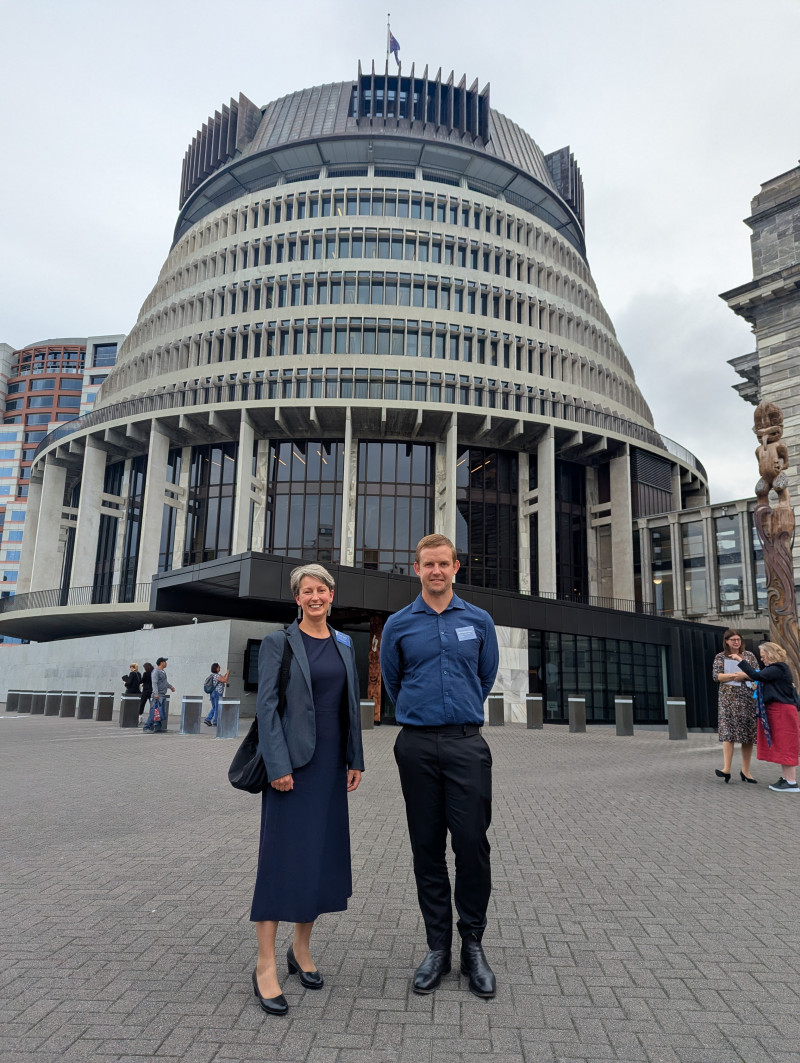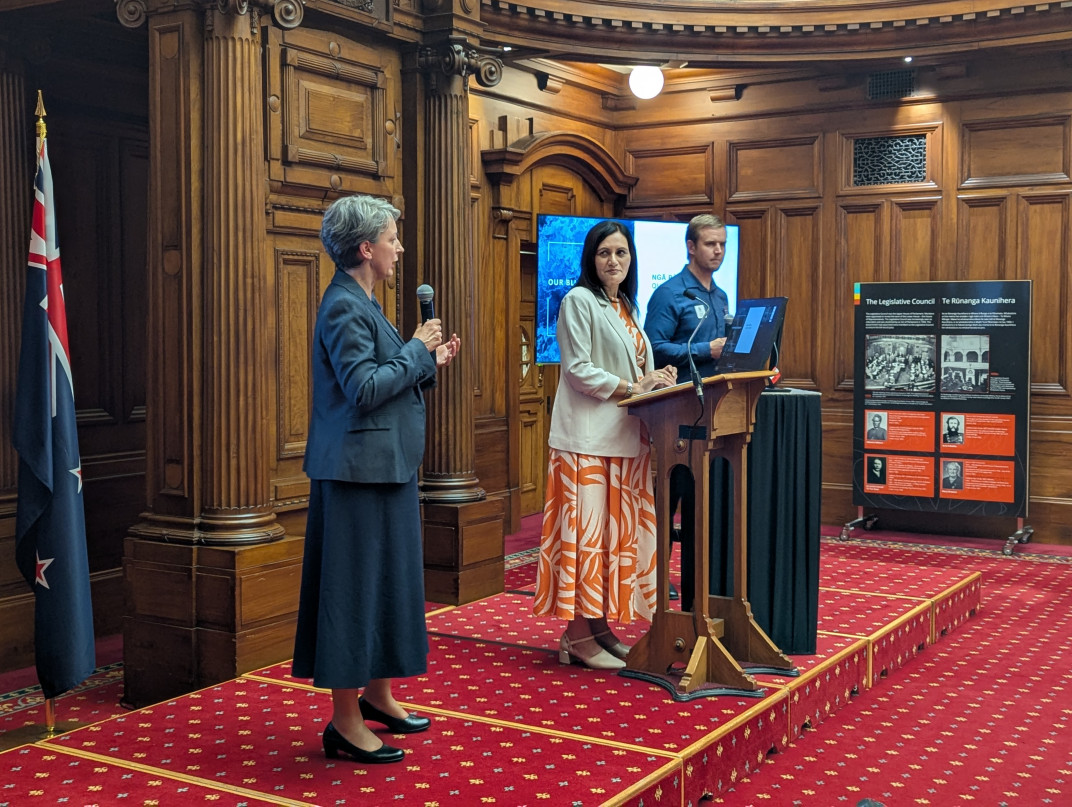Our blue economy
The third event in 2025's Forum was held on 1 Paenga-whāwhā April. MPs learnt about how aquaculture (fish farming) can feed our growing world. Dr Suzy Black spoke about farming fish in mobile enclosures and Dr Patrick Cahill spoke about a variety of aquaculture techniques for shellfish and seaweeds.

Dr Suzy Black and Dr Patrick Cahill at Parliament
Open-ocean aquaculture for Aotearoa
Dr Suzy Black, Plant & Food Research
'Dr Suzy Black, Senior Scientist at Plant & Food Research, spoke about the opportunity New Zealand has for farming finfish in the open ocean. In-shore fish farming has been developed over many years in this country, but a bigger challenge is to develop systems for use in the open ocean that are able to support healthy fish growth, limit adverse impacts on the marine environment and withstand the physical impacts of sometimes harsh and unpredictable offshore conditions.
Dr Black spoke about how the global demand for seafood continues to soar and that aquaculture is growing faster than any major food production sector. Currently in-shore farming in New Zealand is limited to sites in Marlborough, Canterbury and Southland, totalling around 14 ha, with only one species (Chinook/King salmon, or hāmana) famed in the sea. However, New Zealand has a not-so secret weapon when it comes to expansion into the open ocean – the 5th largest Exclusive Economic Zone (EEZ) in the world. Compared to conventional in-shore aquaculture, open ocean aquaculture is the farming of fish in deep, less sheltered waters far from the coast, exposing them to stronger ocean currents and more natural conditions. The recent release of the New Zealand Aquaculture Strategy has open ocean aquaculture contributing to nearly half of the $3B annual revenue goal, with farming of salmon making up the majority of this.
Dr Black described the heavily-engineered approach the rest of the world tends to be taking in the open ocean aquaculture space, and outlined some of the challenges, including the significant capital outlay required for such systems. She also described the challenges New Zealand would face if we were to use these ‘off-the-shelf’ systems, including site selection, suitability of these systems for our environmental and benthic conditions, operating in the offshore environment, as well as the regulatory landscape.
Faced with these challenges, the team at Plant & Food Research have taken a revolutionary approach and designed their system to create a system focused on growing fish in the best conditions year-round. The system being developed takes a revolutionary approach to aquaculture – mobility of a submerged, soft-engineered fish enclosure being the key point of difference. Benefits of such a system would alleviate a number of existing issues aquaculture faces around social license, environmental footprint, and biological challenges as well as provide resilience to climate change and an opportunity for species diversification.
Over the last 5 years there has been significant investment in this research from the MBIE Endeavour Fund, as well as internal investment from Plant & Food Research. Dr Black described the research’s stepping-stone approach toward the vision of being fully mobile – demonstrating the proof-of-concept of the submerged soft-engineered fish enclosure being attached to a single-point mooring together with a support and monitoring buoy that provides all the feeding and communications technology needed to remotely operate the system. The biggest hurdle has been negotiating the resource consenting process for conducting short-term, research-scale trials – the same process had to be followed as if they were a commercial fish farm wanting a consent for 35 years.
Dr Black closed her presentation by looking to the future and the growth that could be achieved if open ocean aquaculture could be realised in New Zealand, not only with salmon but with other New Zealand species such as snapper/tāmure, trevally/araara and butterfish/mārari. She then outlined the future pathway beyond proof-of-concept of technical feasibility toward commercial feasibility, and that it would require significant investment and alignment of all parties to realise the full potential of open ocean aquaculture in New Zealand.'

Dr Suzy Black and Dr Patrick Cahill answer MPs' questions with event host Dr Parmjeet Parmar MP.
Our future is low trophic (and blue!)
Dr Patrick Cahill, Cawthron Institute
"Aquaculture has big potential to grow our economy – we are currently realising less than 5% of the sustainable biophysical potential for aquaculture in New Zealand. A prosperous, resilient future aquaculture sector calls for diversity and sustainability, with low trophic aquaculture an important component. Low trophic aquaculture is the farming of aquatic primary consumers (e.g., seaweeds) and aquatic primary producers (e.g., shellfish). New Zealand are world-leaders in low trophic aquaculture, exemplified by our iconic Greenshell™ mussel farming sector. Low trophic species are inherently geared toward high productivity, and by farming the right species we can deliver high value products to domestic and international consumers.
This talk describes work undertaken at Cawthron to deliver volume and value from low trophic aquaculture using examples of total domestication of the Greenshell™ mussel, seaweed and shellfish new species pipelines, and a seafood functional health claim.
Domestication of the Greenshell™ mussel took a decade of fundamental research into larval biology and hatchery technology. The research spun out into the SpatNZ mussel hatchery, which now provides around a third of mussel spat to industry, and other hatcheries are under development. Domestication has also enabled selective breeding of mussels, with examples of selectable traits including growth rate, appearance, thermal tolerance, and disease resistance.
Cawthron’s new species pipeline for shellfish aims to replicate this success with other shellfish species. Species currently in the pipeline include paua, scallops, geoduck, kopakopa/ribbed mussel, Toheroa, and flat oysters. By way of example, geoduck are a burrowing clam worth more than $25 per individual and research at Cawthron successfully closed the lifecycle and developed grow-out systems. Research is also being undertaken to support the establishment of a seaweed sector in NZ. Species currently being worked on include Asparagopsis, Lessonia, and Karengo. Karengo is the native version of Nori (the seaweed wrapped around sushi), and work aims to close its lifecycle and demonstrate health promoting effects of our native species.
In line with potential health benefits of Karengo, Cawthron-led research has also underpinned a functional health claim for Greenshell™ mussels. Eating Greenshell™ mussel flesh and extracts has been linked to improved joint health in humans, and reductions in the symptoms of osteoarthritis and improved mussel recovery after exercise have been demonstrated in clinical trials. These results have been used in product claims, and more broadly highlight the potential of this type of research to boost the returns from aquaculture.
To realise the opportunity of low trophic aquaculture, collaboration amongst scientists and industry is essential to overcome increasing challenges in the growing environment that are driven by climate change, coastal pollution, and introduced pests and diseases. Proactively developing gold-standard biosecurity and food safety systems for aquaculture is a critical priority to ensure resilience of the sector as it grows. There is also increasing recognition that entirely new approaches to farming in the coastal environment are needed, and Cawthron research is increasingly focused on developing multi-species farming. Multi-species farming has potential to introduce ecological resilience into aquaculture systems, and the key challenge is to now translate this concept for hypothetical to practical.
The future for aquaculture in New Zealand is bright, and with ongoing innovation and collaboration low trophic aquaculture can be an exemplar for sustainable value generation."
